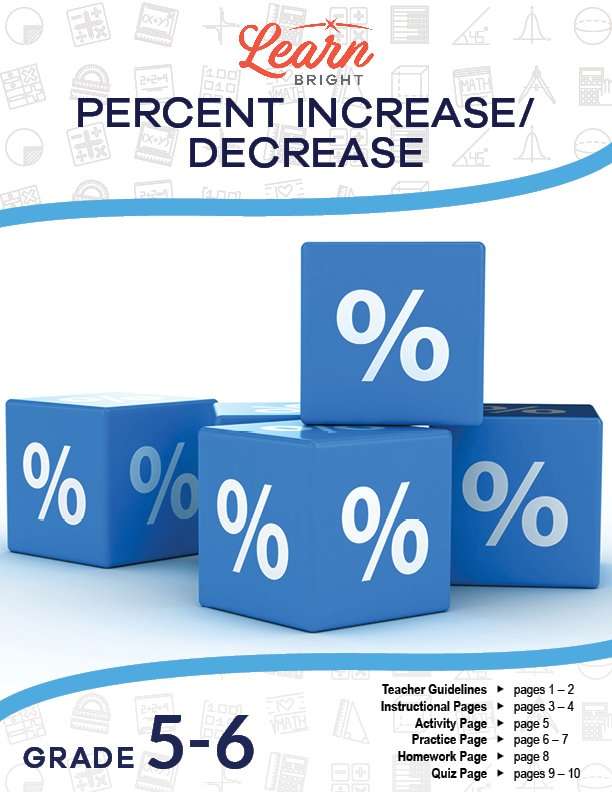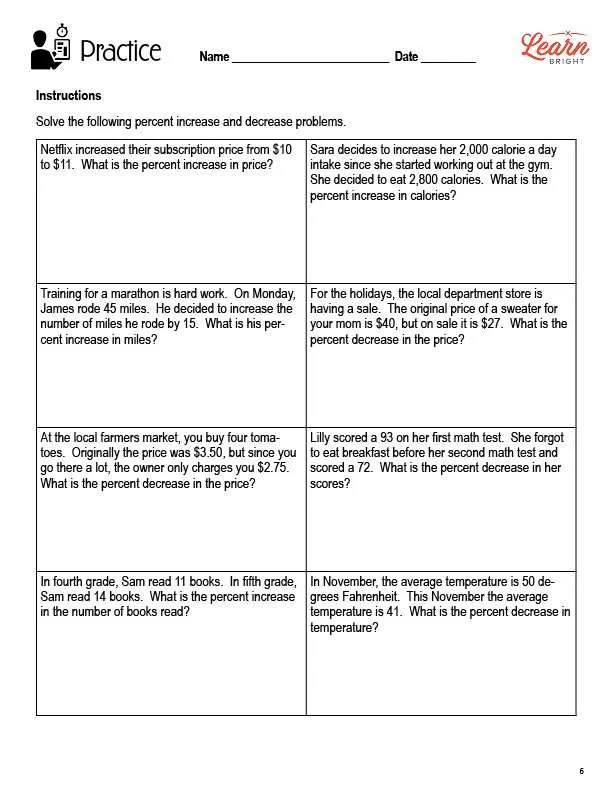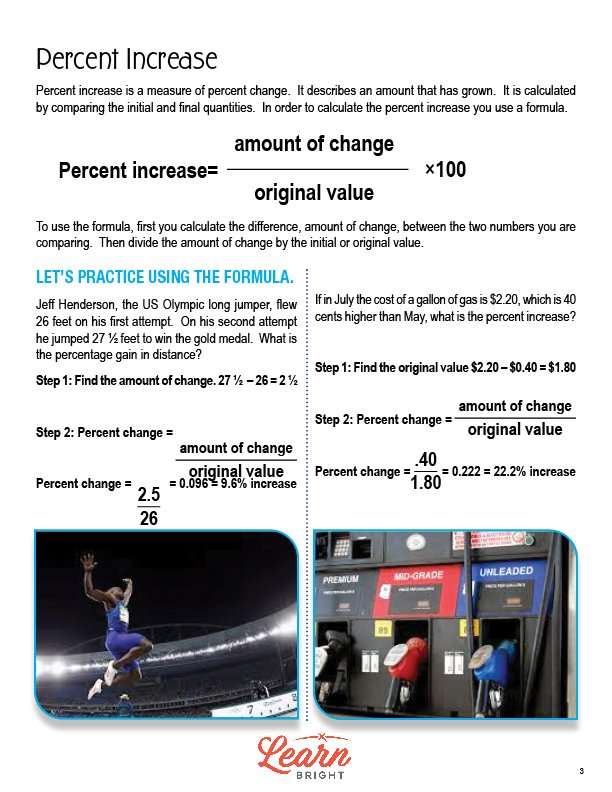Description
What our Percent Increase/Decrease lesson plan includes
Lesson Objectives and Overview: Percent Increase/Decrease provides the mathematical formula to determine percent increase and percent decrease. The formulas are presented individually with examples demonstrating how to use them. At the end of the lesson, students will be able to solve problems using the formula for percent increase and decrease. This lesson is for students in 5th grade and 6th grade.
Classroom Procedure
Every lesson plan provides you with a classroom procedure page that outlines a step-by-step guide to follow. You do not have to follow the guide exactly. The guide helps you organize the lesson and details when to hand out worksheets. It also lists information in the blue box that you might find useful. You will find the lesson objectives, state standards, and number of class sessions the lesson should take to complete in this area. In addition, it describes the supplies you will need as well as what and how you need to prepare beforehand.
Options for Lesson
Included with this lesson is an “Options for Lesson” section that lists a number of suggestions for activities to add to the lesson or substitutions for the ones already in the lesson. One optional adjustment to the lesson activity is to have your students use a different year to compare prices. Your students can also use a price they think it will be in the future and find the percent change. For an additional activity, you can have your students interview their grandparents about price changes and calculate the percent change. You can also have your students research their own interest and create four to five problems based on what they find.
Teacher Notes
The teacher notes page includes lines that you can use to add your own notes as you’re preparing for this lesson.
PERCENT INCREASE/DECREASE LESSON PLAN CONTENT PAGES
Percent Increase
The Percent Increase/Decrease lesson plan includes two content pages. Percent increase is a measure of percent change. It tells you the amount that something has grown. You calculate percent increase by comparing the initial and final quantities of something using a formula.
The formula for calculating percent increase is Percent increase = amount of change / original value x 100. To use this formula, you first need to calculate the difference (the amount of change) between the numbers you want to compare. You then divide that amount of change by the original value.
Let’s look at an example. Jeff Henderson, the US Olympic long jumper, flew 26 feet on his first attempt. On his second attempt he jumped 27 ½ feet to win the gold medal. What is the percentage gain in distance?
To solve, our first step is to find the amount of change: 27.5 – 26 = 2.5. Next, we divide that amount by the original value: 2.5/26 = 0.096 = 9.6% increase. The percentage gain in distance (percent increase) is 9.6%.
Let’s look at another example. If in July the cost of a gallon of gas is $2.20, which is 40 cents higher than May, what is the percent increase?
In this problem, we are given the amount of change. Therefore, our first step is to find the original value: $2.20 – $0.40 = $1.80. Next, we divide the amount of change by the original value: .40/1.80 = 0.222 = 22.2% increase. The percent increase in the cost of a gallon of gas from May to July is 22.2%.
Percent Decrease
Percent decrease is also a measure of percent change. It tells you the amount that something has lost. You calculate percent decrease by comparing the initial and final quantities of something using the same formula as percent increase.
The formula for calculating percent decrease is Percent decrease = amount of change / original value x 100. To use this formula, you first need to calculate the difference (the amount of change) between the numbers you want to compare. You then divide that amount of change by the original value.
Let’s look at an example. When I took my dog to the vet, he weighed 37 pounds. The vet said that is too big for a pug and he should lose some weight. In a month, after a new diet and exercise, he weighed 25 pounds. What is the percentage loss in weight?
To solve, our first step is to find the amount of change: 37 – 25 = 12. Next, we divide that amount by the original value: 12/37 = 0.324 = 32.4% decrease. The percentage loss in weight (percent decrease) is 32.4%.
Let’s look at another example. If in July the cost of a gallon of gas is $2.20, which is 30 cents less than May, what is the percent decrease?
In this problem, we are given the amount of change. Therefore, our first step is to find the original value: $2.20 + $0.30 = $2.50. Next, we divide the amount of change by the original value: .30/2.50 = 0.12 = 12% decrease. The percent decrease in the cost of a gallon of gas from May to July is 12%.
PERCENT INCREASE/DECREASE LESSON PLAN WORKSHEETS
The Percent Increase/Decrease lesson plan includes four worksheets: an activity worksheet, a practice worksheet, a homework assignment, and a quiz. You can refer to the guide on the classroom procedure page to determine when to hand out each worksheet.
PRICE CHANGE OVER TIME ACTIVITY WORKSHEET
For the activity worksheet, students will find the change in price of different products over time. They will research how much each product costs now and how much it cost in 1980. They will then find the percent increase or decrease for each product.
WORD PROBLEMS PRACTICE WORKSHEET
The practice worksheet asks students to solve eight percent increase and decrease word problems.
PERCENT INCREASE/DECREASE HOMEWORK ASSIGNMENT
For the homework assignment, students will fill in the blanks in six word problems and then solve.
QUIZ
This lesson also includes a quiz that you can use to test students’ understanding of the lesson material. For the quiz, students will write down the formula for percent increase and decrease.
Worksheet Answer Keys
This lesson plan includes answer keys for the practice worksheet and the quiz. If you choose to administer the lesson pages to your students via PDF, you will need to save a new file that omits these pages. Otherwise, you can simply print out the applicable pages and keep these as reference for yourself when grading assignments.









